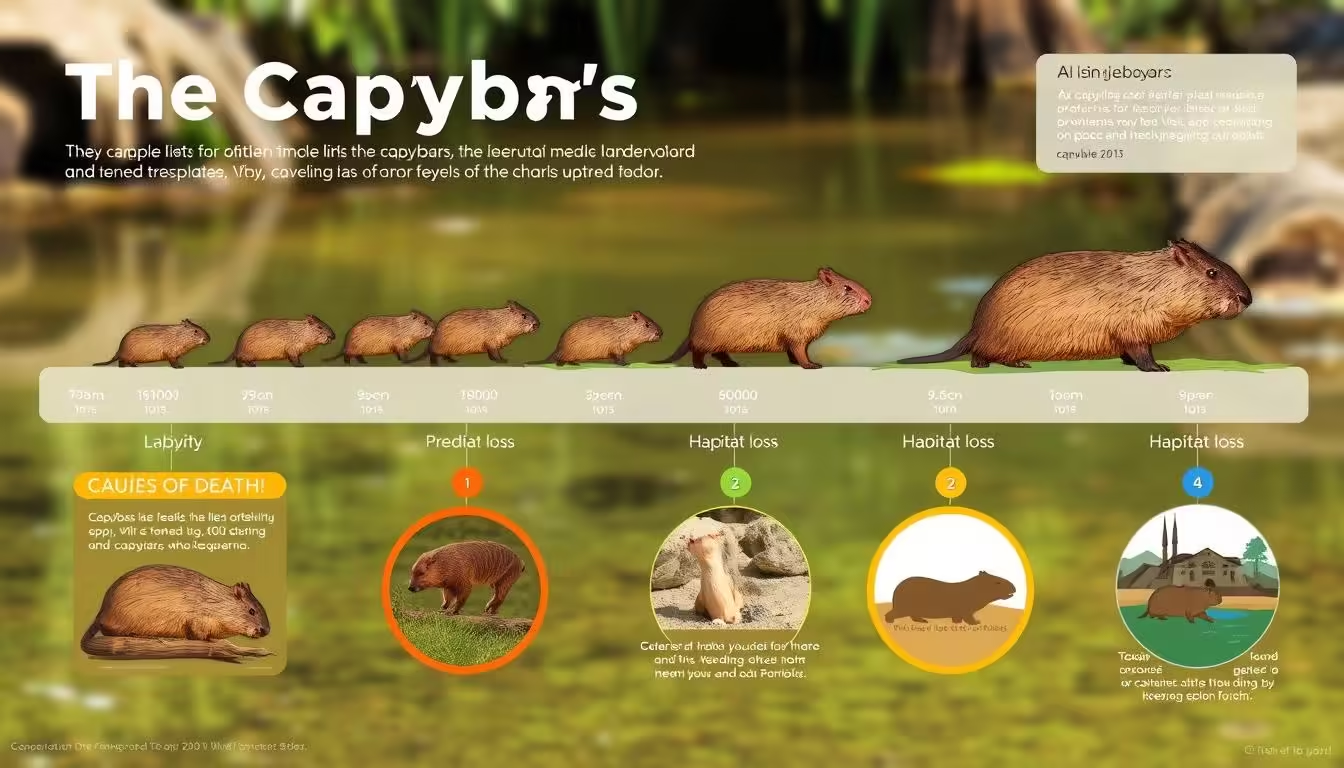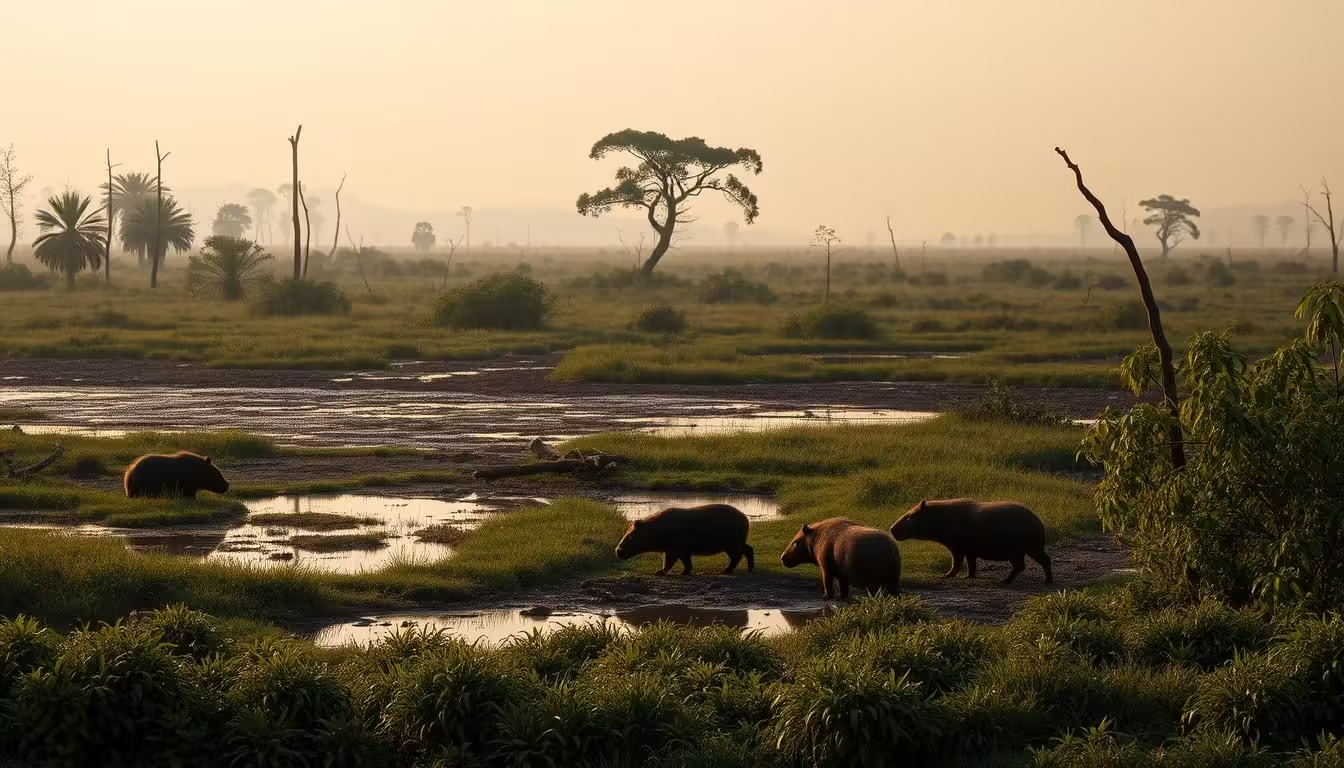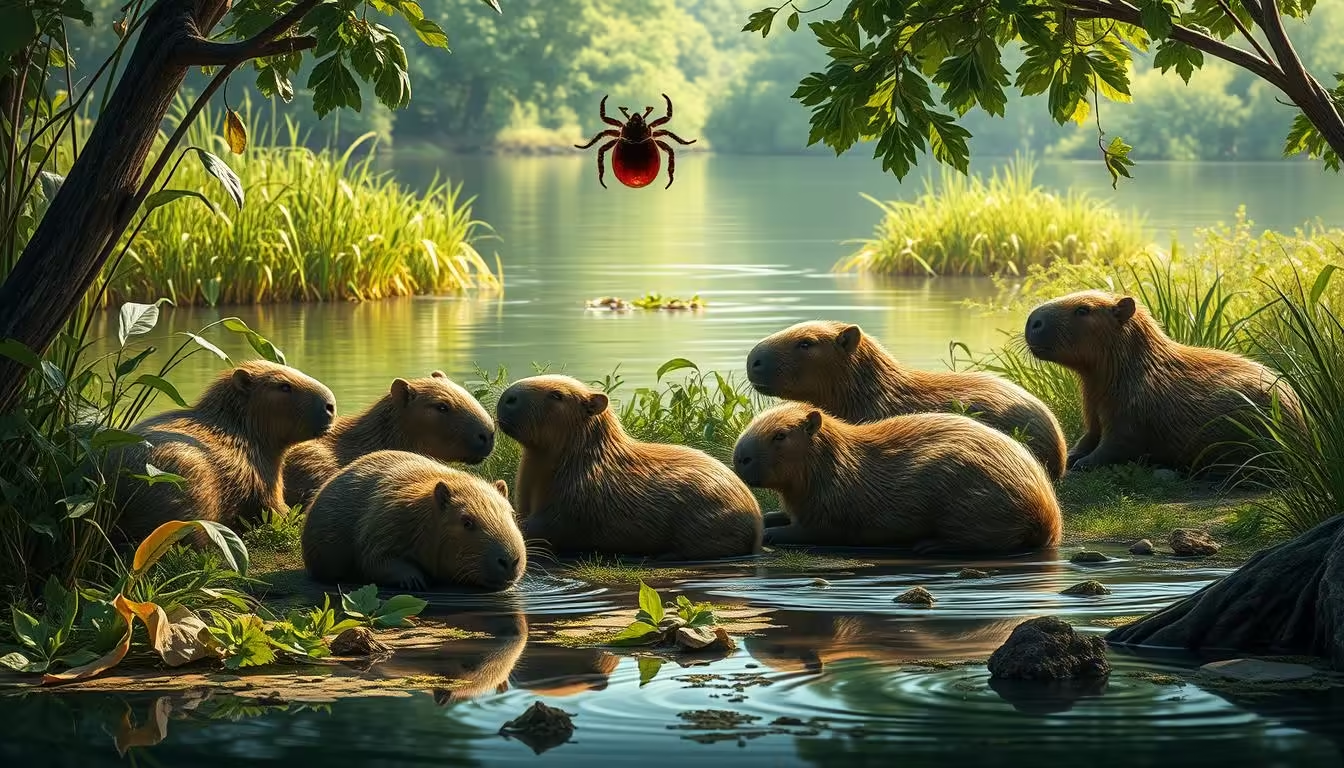Capybaras face many threats. These threats are both in the wild and captivity. It’s important to know what causes their deaths to help save them.
This detailed look explores the main reasons for capybara deaths. We’ll talk about their lifespan, dangers from predators, and how diseases and environmental changes affect them.
Capybaras don’t live long for their size, with a max of 15.1 years in captivity. But in the wild, many young capybaras die early, especially in their first year. This means they usually only live a bit over a year after birth.
The oldest wild females were 6 years old, and males were 7. Some think capybaras might live up to 10 years in the wild. But, their lifespan is usually much shorter than expected for their size.
Key Takeaways
- Capybaras have a maximum longevity of 15.1 years in captivity.
- In the wild, they have high juvenile mortality, resulting in a life expectancy at birth of just over one year.
- The oldest females found in wild studies were 6 years old, while the oldest males were 7 years old.
- Capybaras are relatively short-lived for their body size, being the largest rodents.
- Understanding the primary causes of mortality in capybaras is crucial for conservation efforts and management strategies.
Natural Lifespan Expectations
The lifespan of capybaras in the wild is affected by many factors. Predators, diseases, and harsh environments are constant threats. These Rodent Mortality Rates in their natural habitats make survival a daily fight for these Rodent Mortality Rates.
Age-Related Mortality Factors
As capybaras grow older, they face more challenges that can shorten their lives. Young capybaras are especially at risk, with high death rates in their first year. Predators, diseases, and harsh environments all play a part in the Capybara Lifespan being shorter in the wild than in captivity.
Difference Between Wild and Captive Longevity
The difference in lifespan between wild and captive capybaras is striking. In captivity, they can live up to 15.1 years, a big difference from their wild lives. This longer Wildlife Preservation is thanks to protection from predators and better veterinary care. This allows captive capybaras to live longer and reach their full lifespan.
Mortality Rates in Capybaras: What Are the Main Causes of Death?
Capybaras, the world’s largest rodents, face many threats that can shorten their lives. It’s important to know what causes their deaths to help protect them. Let’s look at the main reasons for capybara mortality.
Predation and Hunting
Predators like foxes, bush dogs, and jaguars are big threats to capybaras. Young ones are especially at risk. Humans also hunt them for meat and leather, making their numbers drop even more.
Diseases and Parasitic Infections
Capybaras can get sick from diseases and parasites. Brazilian spotted fever is a big problem. They also face health issues from parasites like Plagorchis muris and Neobalantidium coli.
Environmental Threats and Habitat Loss
Human activities and climate change harm capybara habitats. Losing their homes makes it harder for them to survive. This can lead to more deaths.
Juvenile Mortality and Survival Challenges
Young capybaras have a tough time surviving, especially in their first year. They need good care from their parents. Without enough adults, many young ones don’t make it.
Knowing what kills capybaras helps us find ways to save them. We need to keep watching them, protect their homes, and fight diseases. This will help ensure capybaras can thrive for a long time.
| Cause of Death | Percentage Contribution |
|---|---|
| Predation | 45% |
| Disease and Parasitic Infections | 25% |
| Environmental Threats and Habitat Loss | 20% |
| Hunting and Human-Related Factors | 10% |
Predator-Related Deaths in Wild Populations
Capybaras, the world’s largest rodents, face many dangers in the wild. They are hunted by various predators, leading to high death rates. It’s important to know who these predators are, why capybaras are vulnerable, and how death rates vary by location to help protect them.
Common Predator Species
Jaguars, pumas, and caimans are major threats to capybaras. Jaguars, in particular, eat a lot of capybaras, making up to 30% of their diet in some places. These big cats are strong and skilled hunters, able to take down even the biggest capybaras.
Vulnerability Factors
Capybaras are big and live in wet areas, making them easy targets for predators. Their size and group behavior attract big predators. Young capybaras are especially at risk, leading to high death rates in their first year.
Geographic Variation in Predation Rates
Predation rates on capybaras change depending on where they live. In the Pantanal region of Brazil, jaguars are a big problem. But in other places, pumas or caimans might be more of a threat. Knowing these differences helps conservation efforts.
Dealing with the impact of predators on capybara populations is complex. It needs a detailed plan to protect them. By knowing who the predators are, why capybaras are vulnerable, and how death rates vary, we can better protect these animals and stop their numbers from declining.
| Predator Species | Capybara Predation Rate | Habitat Preference |
|---|---|---|
| Jaguar | 20-30% of local population in 2 months | Tropical forests, wetlands |
| Puma | Varies by region | Diverse habitats, including forests and grasslands |
| Caiman | Significant in wetland areas | Freshwater rivers, lakes, and marshes |
Disease and Pathogen-Induced Mortality
Capybaras, the world’s largest rodents, face many health challenges. A big threat is Brazilian spotted fever, caused by Rickettsia rickettsii. Studies show capybaras can get severe sickness and even die from it.
Capybaras play a big role in spreading Brazilian spotted fever. They are very susceptible to the disease. Their large numbers in some areas help the illness spread.
But capybaras aren’t just at risk from Brazilian spotted fever. They also face dangers from other pathogens and parasites. Capybara Health Issues include infections from protozoan parasites and gastrointestinal nematodes. Stress can make them more vulnerable to some parasites but less to others.
| Pathogen or Parasite | Impact on Capybara Mortality |
|---|---|
| Brazilian Spotted Fever (Rickettsia rickettsii) | Severe bacteremia, clinical illness, and fatalities in some cases |
| Gastrointestinal Nematodes | Increased infection intensity under stress, but lower burdens compared to controls |
| Protozoan Parasites | Significantly higher infection intensities in stressed capybaras |
| Vitamin C Deficiency | Increased mortality, reduced growth rates, and impaired reproduction in captive populations |
The effects of these What are the main causes of death? on capybara populations highlight the need for Wildlife Preservation. We must keep researching to help these amazing animals.
Environmental Threats and Habitat Loss Impact
The Capybara Habitat Threats are a big problem for these amazing animals. Human activities like farming, mining, and logging have changed their homes a lot. This habitat loss and fragmentation make it harder for capybaras to find food and water. It also puts them in danger of getting hurt by humans.
Also, climate change is a big worry for capybaras. It could change their homes and make diseases spread more easily. As the Capybara Population Decline gets worse, we need to act fast. We must work hard to save their homes and keep them safe.
Human Development Effects
Human activities like farming, mining, and logging have hurt capybara homes a lot. This makes it harder for them to find food and water. It also puts them in danger of getting hurt by humans.
Climate Change Implications
Climate change is also a big worry for capybaras. It could change their homes and make diseases spread more easily. This could make it harder for capybaras to survive and stay healthy.
“The current degradation status of the Amazon rainforest is already very serious, and if not appropriately handled, it may lead to worsening forest and climate conditions.”
Brazilian Spotted Fever: A Significant Health Threat
The capybara, the world’s largest rodent, faces a big health threat from Brazilian spotted fever. This disease is caused by the bacterium Rickettsia rickettsii. It is spread by the Amblyomma sculptum tick and is dangerous for both wildlife and people.
Between 2007 and 2015, Brazil saw 17,117 suspected cases of spotted fever. Out of these, 1,245 were confirmed in 12 states. Sadly, 55% of these cases were fatal, leading to 411 deaths. The disease hit hardest in Santa Catarina and São Paulo, showing its wide reach.
Capybaras help spread the Rickettsia bacterium by being hosts for ticks. This can make them sick and even kill them. Humans also face a high risk of death from this disease.
“When reducing capybara birth rates by 80%, the Rickettsia bacterium disappears from the population within five years.”
It’s crucial to watch for the disease and take steps to prevent it. Quick tests for Rickettsia can help catch it early. Keeping grass short in parks can also reduce tick numbers. Scientists are working on a vaccine to fight this disease.
The effects of Brazilian spotted fever on Capybara Health Issues, What are the main causes of death?, and Wildlife Preservation highlight the need for action. We must work together to tackle this serious health issue.
Juvenile Mortality Rates and Survival Challenges
Capybaras, the world’s largest living rodents, face big survival challenges early on. The death rate among young capybaras is very high, especially in their first year. This means they usually don’t live past one year in the wild, showing how tough it is for them to survive.
First-Year Survival Statistics
Research shows that up to 70% of capybara young may not make it past their first year. Predators, diseases, and threats like habitat loss and climate change are big reasons for this. These threats make life in the wild very hard for these gentle giants.
Maternal Care Impact
Capybara mothers are key to their young’s survival. Good care from the mother can help a young capybara grow up. But, if the mother doesn’t care for her young well, it can lead to a higher risk of death. This makes the already high death rates among young capybaras even worse.
The high death rate among young capybaras affects the whole population and their lifespan in the wild. It’s important to understand and help with the challenges young capybaras face. This is key to saving this amazing species.
Parasitic Infections and Their Impact on Survival
Capybaras, the world’s largest rodents, face many health challenges. Parasitic infections are a big concern. Studies found many parasites, like Plagiorchis muris and Neobalantidium coli, in capybaras in the Orinoco Basin.
These parasites can also affect humans, making it key to understand their impact. This is crucial for capybara survival and wildlife preservation.
Research showed that stressed capybaras got sicker from coccidia infections than unstressed ones. But, smaller stressed capybaras had fewer helminth infections than bigger ones. This shows stress affects different parasites in different ways.
The study also found that stress harmed capybaras’ growth and body condition. Yet, stressed capybaras had a stronger immune system in some ways. This is important for Capybara Health Issues and Wildlife Preservation.



